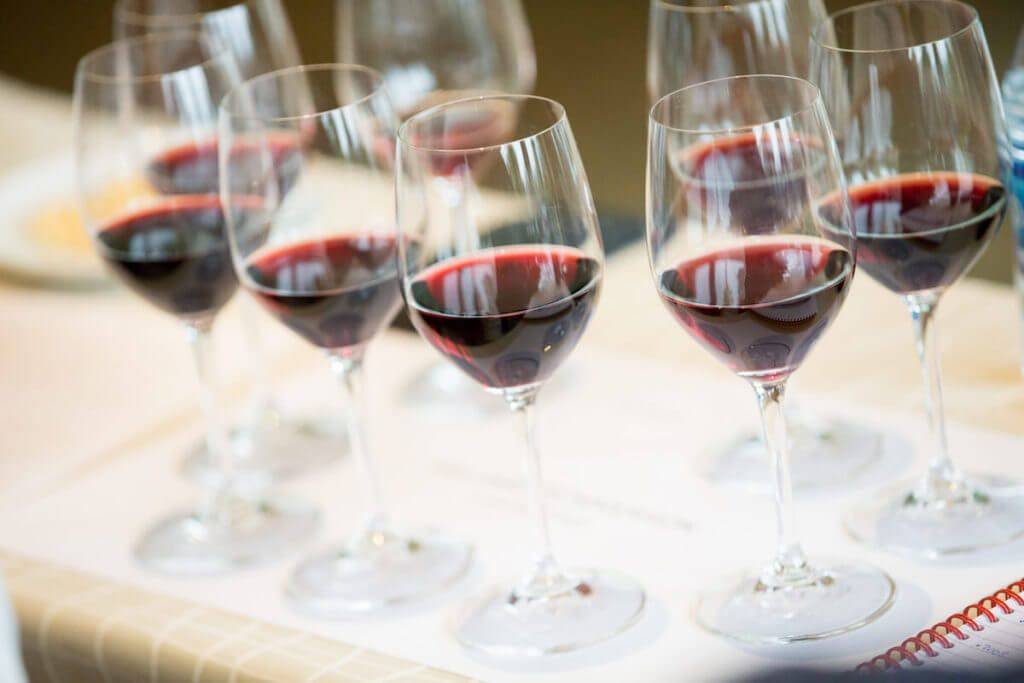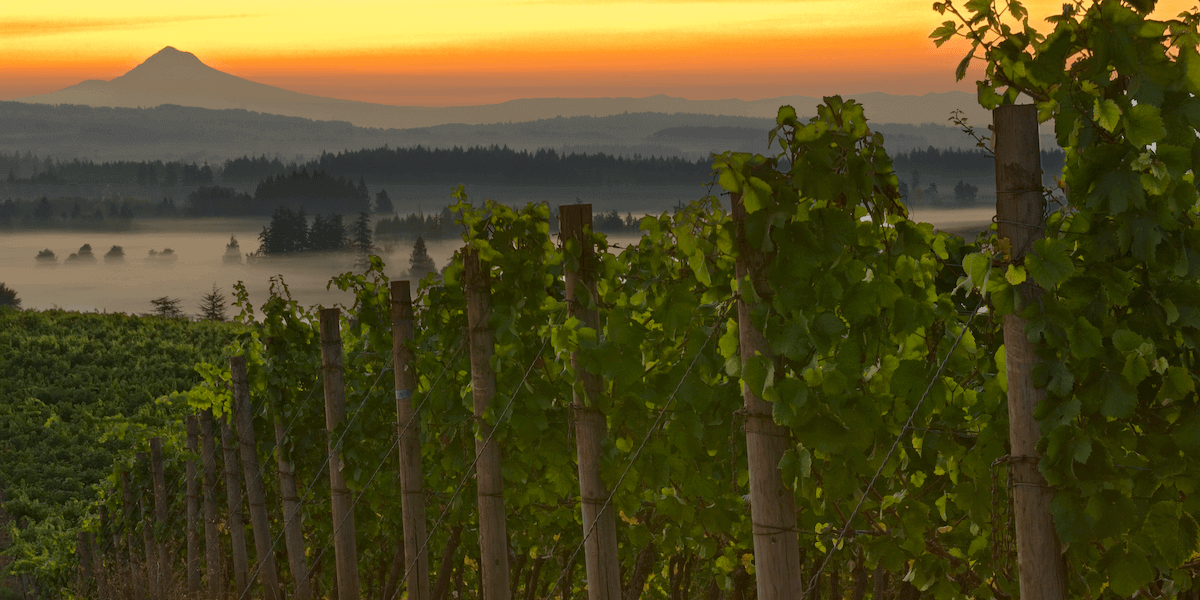by Julia Burke, Marketing and Communications Coordinator, Willamette Valley Wineries Association, WSET III
When was the last time you tasted a New World Pinot Noir that was more than four to five years old? While Pinot geeks have no problem with the idea of a Gevrey-Chambertin that needs five years, 10 years, or more to show its full potential, the conventional wisdom, transmitted from wine media and sommeliers to consumers, has often been that New World Pinot Noir is always made in a fresh, fruity style best enjoyed sooner than later. But considering the tremendous difference between Pinot sites and winemakers from Central Otago to Santa Barbara to the Hemel-en-Aarde Valley, such a generalization bears closer to scrutiny. As an AVA with just a half-century winemaking history (the first vines were planted in 1966) and an increasing focus on age-worthiness in recent years, Oregon’s Willamette Valley is a vibrant example of a Pinot region whose producers are eager to dispel the myth that New World Pinot doesn’t age.
“Aged wines can have a fabulous story to tell and can contribute to a meal as much as great conversation—it’s an incredibly important part of the wine drinking experience for me,” says Robert Brittan, winemaker at Brittan Vineyards. “That’s what brought me to Oregon.”
After making wine at Stag’s Leap, Far Niente and Saint Andrews in Napa, Brittan moved to the Willamette Valley and now makes wine for several local brands in addition to his own. He says he intends to drink his own Oregon wines for decades to come, adding, “Right now I’m drinking ’06 wines that are showing no signs of fading.”
Of all growing regions outside Burgundy, “I really believe Oregon has the chance of making the most age-worth Pinot,” Brittan says. “The problem is our critics are a little too California-centric when they think of New World wines and Pinot Noirs especially. Oregon is a completely different entity, and I’m talking about [comparing] the most desirable places in both states.”
Given the youth of the Willamette Valley as a wine region, “winemaking tradition has really not had this intention of ageability, and that’s changing very rapidly,” Brittan adds. “Winemakers are becoming more astute and more focused.”
How Wine is Built to Last
According to Brittan, the decision to make a wine with aging potential is a conscious one and it starts in the vineyard with well-rooted vines that express something unique. From there, controlling the yield is key. “You can’t ask too much of them, because you’re asking them to give age-worthiness. Cropping, light exposure, all those things are indirectly important,” Brittan says.
That intent carries through harvest and beyond. Structural elements have to be in place for a wine to age well, says Jessica Mozeico, winemaker and co-owner at Et Fille Wines. Acidity is the best-known structural element of longevity. “I believe a key differentiator of the age-worthiness of Willamette Valley Pinot Noir versus other domestic regions is that our climate generally allows us to harvest at a lower pH, so our starting point has a reasonable level of acid to begin the maturation process,” she says, noting that this is especially noticeable in cooler vintages.
Tannin structure must be taken into account, too, which requires intentionality in the cellar in both fermentation and maturation. “I consider both phenolic structure and oak integration when assessing how long the tannins will take to integrate and how much protection they add to the structure and color of the wine in future years,” says Mozeico. “When I am intentionally creating a wine that I would like to age, I consider more whole-cluster fermentation for phenolic complexity and a more pronounced barrel program that may require time to soften.”
Yet it’s not just the Valley’s most high-acid, high-tannin wines that show lasting power. “The classic tenets of ageability aren’t always the ones that age the wine,” points out Ben Casteel, winemaker at Bethel Heights Vineyard. “Eyrie is the classic example—the Dundee Hills* aren’t defined by acidity on the same level that, say, the Eola-Amity Hills AVA is capable of, not defined primarily by tannin, and yet those wines have a track record of aging beautifully.”
Balance, Casteel says, is the key. “We can strike the right balance of favor development, acidity, structure, how the flavors develop, and the entropy of how they break down. ‘Pick early and make sure there’s a screaming amount of acidity’ just isn’t always true,” he explains. “There has to be room for development and there needs to be a certain amount of ripeness already.”
Vintage plays a crucial role in cooler wine growing regions like the Willamette Valley, where variance is notable. Mozeico says she is only now drinking her favorite recent vintage, 2005, and won’t touch her 2011s for several more years. However, “in warmer years, such as 2014 and 2015, those are ready to go immediately and I will drink those within the next five years,” she adds.

Making Room
Casteel points out that sommeliers are in a tough position with aged wine in general because of limited list space. “Varieties like Cab and Nebbiolo that have this giant track record from the New and Old World take up a lot of that precious space,” he says. “It’s the hard thing about being a relatively new wine region.”
And unfortunately, as every member of the trade knows, producers can’t usually hold product as long as they like due to cash-flow and market concerns. “I understand the economics that prohibit aging wines for consumers,” says Mozeico, “but I wish we could more consistently educate consumers on how wines could dynamically change in their cellar and that it is beneficial to evaluate wine not at a single point in time, but over a continuum of years.”
A quick turnover buying cycle isn’t the only challenge when exploring the ageability of Willamette Valley wines. Brittan points out that there are consequences specific to Pinot in the often-discussed double standard between New and Old-World wine criticism. “A reviewer will drink a Burgundy and say it’s young, it’s closed, it’s going to be fabulous 15 years from now, so we’re not going to judge it on today, but on its potential,” he notes. By contrast, Willamette Valley wines that are built to age may not fit the stereotype of what a New World Pinot should be. “My wines aren’t light, red fruit-forward wines; these are darker and more complex and have secondary and tertiary flavors. They are described as not typical of Oregon. And you’d never hear [critics] say that about a Burgundy; they’d say these wines are complex, tight, they’re a little course, so they have great potential for age. There’s a disconnect there.”
What to Drink Now
Getting the chance to taste older vintages from the Willamette Valley may not be easy, but for those who have the opportunity, several winemakers cite 2005, 2007, and 2010 as fantastic vintages that bear out the aging potential they see in the Valley.
Catsteel points to 2011 as an example of a vintage that has surprised him. “2011 is a great example of where you had these truculent and angular wines; there wasn’t a choice of what to make because maturity was so low,” he says. “Those wines have finally just now started to show the promise of that vintage that just took forever to come around.”
According to Casteel, the nature of making cool-climate Pinot is that “you get the grapes as ripe as you’re able before the season dictates the end.” A longer, warmer season offers a broader stylistic palate, but at the same time, he feels constraints are to the benefit of ageability. “It forces you out of your comfort zone as to what the wine is tasting like right now,” he says.
“There’s no recipe to make a wine that tastes good now, and in 10 years, and in 30 years,” Casteel continues. “The wines I’ve made that aged better than expected didn’t win any beauty contests in their youth and had exaggerated traits that kept the wine from being generous, but they came into balance after a few years in the bottle.”
In Burgundy, of course, that’s business as usual. “With some of these Burgundy bottles, if you pop the current release, people think you’re an idiot,” Casteel points out. “That can give a glimpse into what I’m talking about in a younger region. The picking decisions I’ve had to make, as opposed to the decisions I’ve wanted to make, have turned out two to three years later much better than I thought.”
“I would hope that sommeliers, retailers, and even consumers see that there is a huge amount of potential,” Casteel adds. “That’s where Oregon exists right now, I think: this area of limitless potential.”
*The Willamette Valley AVA contains seven nested AVAs: Chehalem Mountains, Dundee Hills, Eola-Amity Hills, McMinnville, Ribbon Ridge, Van Duzer Corridor, and Yamhill-Carlton.







